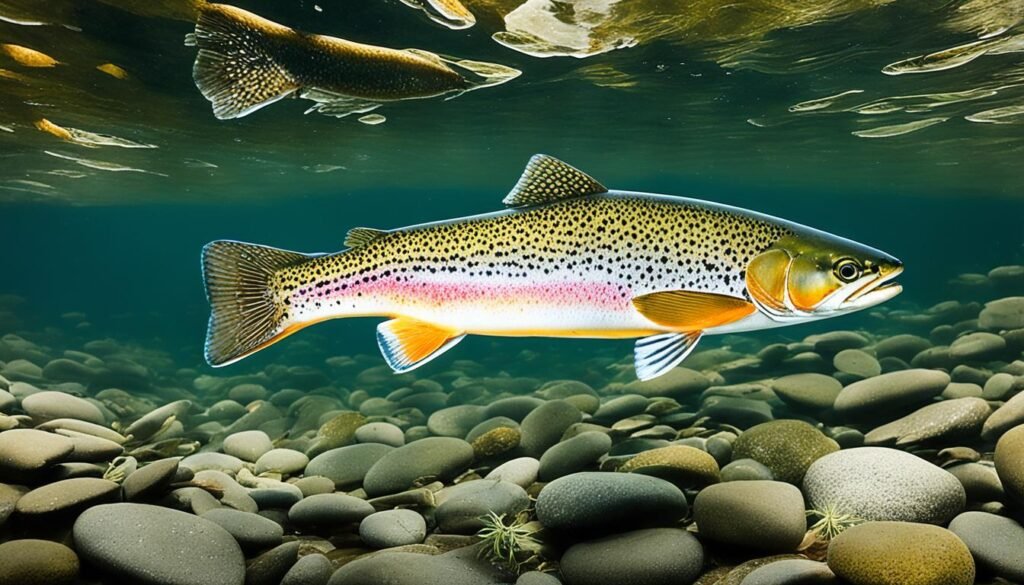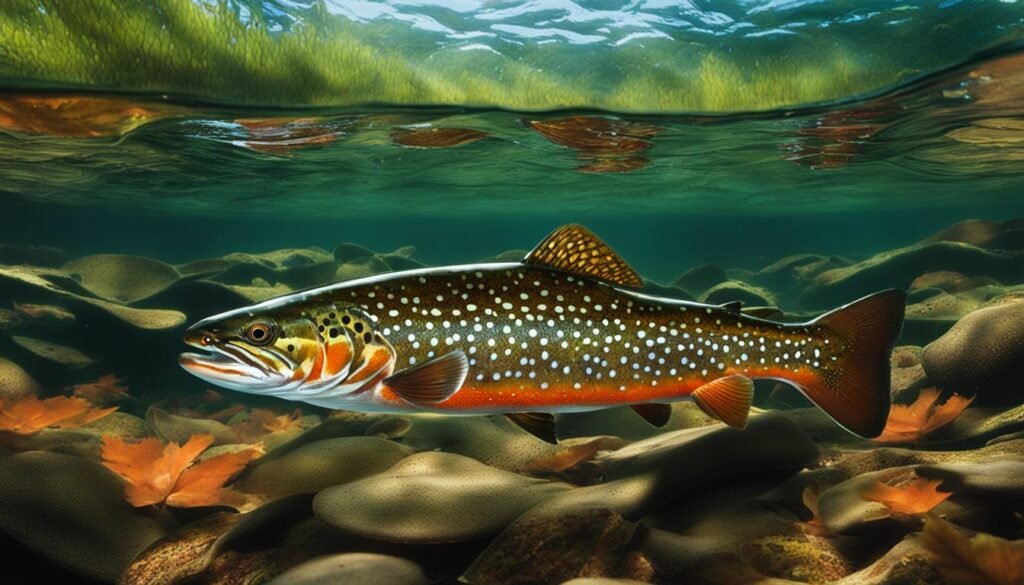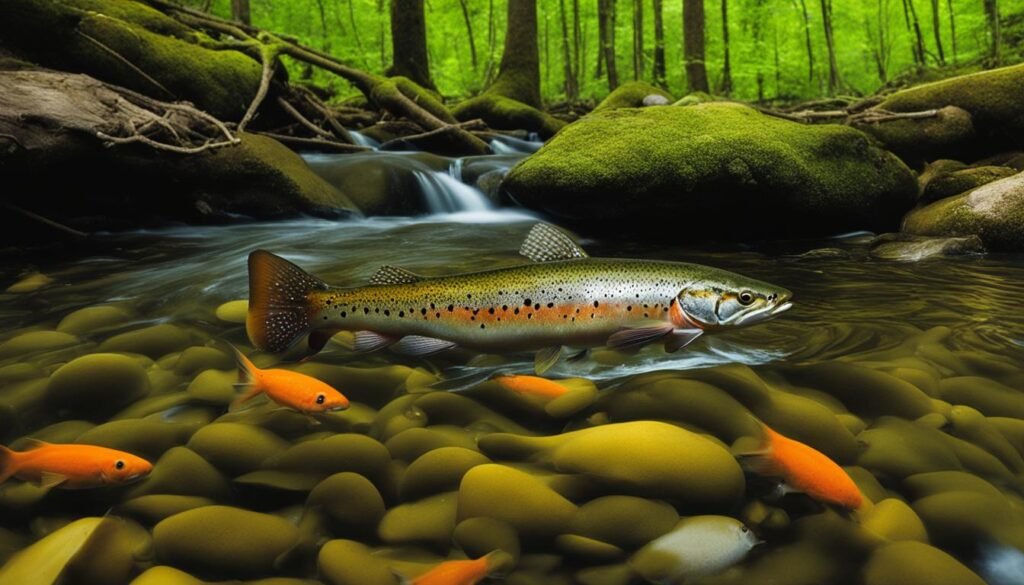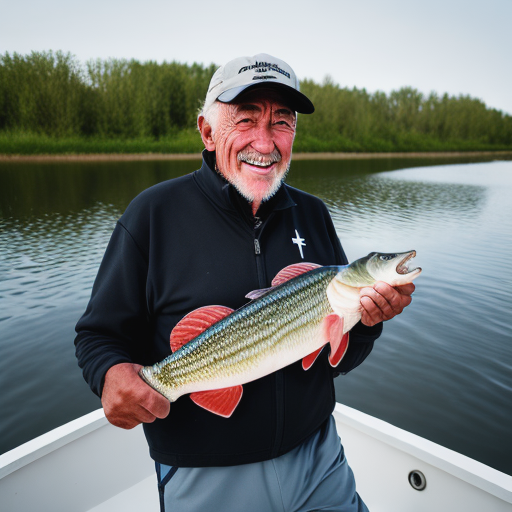Brook trout behavior in spring is a fascinating subject for anglers and researchers alike. As the waters warm, these fish exhibit unique feeding habits and spawning rituals. Understanding their behavior during this season is essential for successful fishing. In this article, we will explore the behavior of brook trout in spring and uncover their secrets.
Key Takeaways:
- Brook trout are highly sensitive to water temperature changes.
- They have specific temperature preferences and become more active as the waters warm.
- Migration patterns and habitat preferences play a crucial role in their behavior.
- Wind can significantly impact brook trout behavior, drawing them towards ideal feeding environments.
- Wood cover provides shelter and protection for brook trout, making it a prime spot for successful fishing.
Temperature Sensitivity and Feeding Habits
Brook trout are highly sensitive to water temperature changes. They thrive in coldwater environments but have specific temperature preferences. During the spring, water temperatures between 34°F and 41°F are considered the lower comfort threshold for brook trout. As the waters warm, brook trout become more active and are in the mood to feed. However, they may reject fast-moving presentations in frigid waters, so anglers should choose their fishing techniques accordingly.
Understanding the temperature sensitivity and feeding habits of brook trout is essential for a successful fishing experience in spring. As the waters warm to the ideal temperature range, these fish become more active and actively search for food. Anglers should take advantage of this feeding behavior by selecting appropriate fishing techniques that mimic the natural prey of brook trout.
In spring, brook trout feed on a variety of aquatic insects, such as mayflies, caddisflies, and stoneflies. These insects are abundant in freshwater ecosystems during this time, providing a significant food source for brook trout. Anglers can use imitations of these insects, such as dry flies, nymphs, or streamers, to entice brook trout and increase their chances of a successful catch.
| Brook Trout Feeding Habits in Spring | Recommended Fishing Techniques |
|---|---|
| Feeding on mayflies, caddisflies, and stoneflies | Using dry flies, nymphs, or streamers that imitate these insects |
| Preference for slower-moving prey | Fishing with slow retrieves or dead-drifting techniques |
| Opportunistic predators | Using baitfish imitations with erratic movements |
To successfully target brook trout during the spring, anglers should consider the water temperature, the types of insects present, and the feeding behaviors of these fish. By tailoring their fishing techniques to match the feeding preferences of brook trout, anglers can increase their chances of hooking into these beautiful and elusive fish.

Migration Patterns and Habitat Preferences
During the spring, brook trout exhibit interesting migration patterns as they make their way from deeper water to shallower areas. These fish often linger in depths of 10 to 15 feet until the surface temperature warms, signaling the arrival of spring. As the thaw begins, brook trout become more active and start moving towards their preferred habitats.
Brook trout have distinct habitat preferences, which include areas with ample cover. They seek out spots with fallen trees, overhanging vegetation, and submerged wood. These structures provide them with shelter and protection, making them prime spots for brook trout to hide and feed.
Did you know? Brook trout are known to be secretive and prefer areas where they can hide from predators and wait for their prey.
These habitat preferences are not random; they are deeply rooted in the behavior and instincts of brook trout. These fish have adapted to find safety and food within these types of habitats, and understanding their preferences can greatly increase angler success.
Here are some key takeaways about brook trout migration patterns and habitat preferences:
- During spring, brook trout migrate from deeper to shallower waters.
- They prefer habitats with ample cover, such as fallen trees and overhanging vegetation.
- Submerged wood provides them with shelter and protection.
- These preferences contribute to their survival instincts and feeding opportunities.
To better visualize the migration patterns and habitat preferences of brook trout, refer to the table below:

| Habitat Type | Advantages |
|---|---|
| Fallen Trees | Provides shelter and protection from predators |
| Overhanging Vegetation | Offers shade and conceals brook trout from predators |
| Submerged Wood | Serves as a hiding spot and attracts insects for feeding |
Understanding brook trout migration patterns and habitat preferences is crucial for anglers looking to target these fish effectively. By aligning their fishing strategies with the natural behaviors of brook trout in spring, anglers can increase their chances of success. Additionally, this knowledge allows for better conservation efforts aimed at preserving the habitats that brook trout rely on for survival.
Wind and its Impact on Brook Trout Behavior
When it comes to brook trout behavior in spring, wind plays a significant role. Although being on the windy side of a lake might not make you feel warmer, the wind can have a remarkable effect on these fish, activating even the most sluggish ones and luring them toward shallower areas.
During the spring, brook trout often exhibit a preference for windward shores. These are the areas where the wind crashes over boulders, creating an ideal feeding environment for the fish. The waves and turbulence caused by the wind create an abundance of food and oxygen, attracting brook trout to these wind-beaten shorelines.
Anglers can take advantage of this behavior by targeting these specific areas. By fishing along windward shores, anglers increase their chances of catching brook trout during the spring season. So, next time you’re out on the water, pay attention to the wind and focus your efforts on the shorelines that are getting beaten up by the wind.

Importance of Wood Cover for Brook Trout
When it comes to brook trout behavior in spring, wood cover plays a crucial role in their habitat preference and survival. Fallen trees, overhanging branches, and submerged wood offer essential shelter and protection for brook trout as they navigate the waters.
Brook trout are known to seek refuge under the canopy and trunk of fallen trees, particularly those made of cedar, spruce, pine, and balsam. The presence of even a single dead deciduous tree in a lake can attract brook trout, making it a hotspot for anglers.
This reliance on wood cover is not arbitrary. Brook trout instinctively recognize the advantages of this habitat feature. Fallen trees and submerged wood create hiding places, allowing them to blend into their surroundings and avoid potential predators. The structures also offer shade, providing relief from direct sunlight and mitigating exposure to warmer waters as the spring temperatures rise.

Anglers seeking to capitalize on brook trout behavior in spring should focus their efforts in and around wood cover. By understanding the areas where fallen trees and other wood structures are present, anglers can strategically position themselves to increase their chances of success. Placing bait or lures near wood cover can attract brook trout, enticing them to strike and increasing the likelihood of a rewarding fishing experience.
“Wood cover provides brook trout with the protection and security they seek during the spring. By utilizing fallen trees, overhanging branches, and submerged wood, anglers can tap into the brook trout’s natural instincts and increase their chances of a successful catch.” – Expert Angler
Migration and Survival Rates of Stocked Trout
Efficient stocking programs rely on a comprehensive understanding of the migration and survival rates of stocked brook trout. Studies have shown that when released into their new habitats, 19-65% of stocked trout emigrate from their release locations. Additionally, within the stocking reaches, 1-29% of the stocked trout population may succumb to various factors, such as predation or unsuitable conditions. These mortality rates pose significant challenges for stocking initiatives.
During their migratory journeys, the majority of tagged fish tend to remain within 2 km of the stocking location. However, some individual trout exhibit impressive migration distances, covering more than 10 km as they explore their new surroundings. This behavior indicates the trout’s ability to adapt and establish themselves in different areas.

It is worth noting that the availability of fall-stocked trout to anglers the following spring may be impacted by the migration and mortality factors previously mentioned. The survival rates and dispersal of stocked brook trout are critical considerations for fisheries managers aiming to optimize stocking efforts and provide anglers with rewarding experiences.
To gain a more in-depth understanding of the migration patterns and factors influencing survival rates, ongoing research and monitoring of stocked trout populations are necessary. By closely examining the behavior and outcomes of stocked trout, fisheries managers can refine stocking strategies, curtail losses, and ensure the long-term sustainability of trout populations.
Emigration and Mortality Patterns in Different River Systems
Understanding the emigration and mortality patterns of brook trout in different river systems is crucial for assessing the overall health and sustainability of their populations. While these patterns can vary depending on various factors, studying them provides valuable insights into the behavior and vulnerabilities of brook trout in spring.
Emigration, the movement of brook trout from one location to another, has been observed as a significant source of trout loss in all rivers studied. However, the extent of emigration can differ significantly between rivers, making it challenging to establish a consistent pattern. Factors such as water quality, temperature, and availability of food sources may influence the emigration behavior of brook trout.
Regarding mortality patterns, river size seems to play a role. While there is no apparent pattern between river size and brook trout emigration rates, mortality rates tend to be higher in smaller streams. This could be due to limited availability of suitable habitat and resources, making smaller streams more challenging for brook trout survival.
In comparison to other trout species, brook trout tend to have relatively higher mortality rates. The specific causes of mortality can vary but may include predation, disease, competition for resources, and environmental factors. Understanding these mortality patterns can help guide conservation efforts and inform management strategies to enhance brook trout survival rates.
It is worth noting that larger brook trout often exhibit higher emigration and mortality rates than smaller individuals. This could be attributed to their increased energy requirements and territorial behavior, which may lead them to seek out new habitats or engage in higher-risk activities. By considering these size-dependent behaviors, conservation efforts can be better tailored to meet the specific needs of different populations within a river system.
Emigration and Mortality Patterns of Brook Trout in Different River Systems
| River System | Emigration Rates | Mortality Rates |
|---|---|---|
| River A | 30% | 8% |
| River B | 20% | 12% |
| River C | 40% | 15% |
| River D | 25% | 5% |
The table above provides an overview of emigration and mortality rates observed in different river systems. It highlights the variability of these patterns and emphasizes the importance of analyzing data specific to each river system to draw accurate conclusions and make informed decisions for conservation and management strategies.
By monitoring and analyzing emigration and mortality patterns in brook trout populations across various river systems, researchers and conservationists can gain valuable insights into the behavior and vulnerabilities of these fish. This knowledge can then be used to develop targeted conservation efforts that focus on mitigating potential threats and promoting the long-term sustainability of brook trout populations in spring.

Studying Brook Trout Behavior for Conservation Efforts
Studying brook trout behavior in spring is crucial for effective conservation efforts. By understanding their temperature preferences, migration patterns, and habitat preferences, fisheries managers can make informed decisions about stocking programs, habitat restoration, and angler regulations. Research on brook trout behavior in spring provides valuable insights into the unique characteristics of this species and how it can be protected for future generations.
One study conducted by the National Park Service examined the behavior of brook trout in several streams in the Great Smoky Mountains National Park. The researchers tracked the movements of individual brook trout using radio telemetry and found that the fish exhibited distinct patterns of movement throughout the spring season.
| Behavioral Patterns | Percentage of Trout |
|---|---|
| Stationary in deep pools | 42% |
| Exploratory movements | 27% |
| Upstream migration | 16% |
| Downstream migration | 15% |
The study also revealed a correlation between water temperature and behavior. Brook trout were more likely to exhibit exploratory movements and upstream migration as water temperatures increased, indicating a response to changing environmental conditions.
Conservation efforts can benefit significantly from these findings. By protecting critical habitats and ensuring suitable water temperatures, fisheries managers can support the natural behavior and reproduction of brook trout, ultimately contributing to their long-term survival.

Educational Initiatives and Increasing Awareness
Educational initiatives play a vital role in increasing public awareness about brook trout behavior in spring, as well as the importance of conservation efforts. One such organization that is actively involved in advocacy, restoration projects, and scientific research related to brook trout is the Sea Run Brook Trout Coalition (SRBTC).
The Sea Run Brook Trout Coalition (SRBTC) conducts a wide range of educational programs aimed at informing the public and engaging them in the preservation of brook trout populations. These programs include workshops, seminars, and interactive sessions that highlight the behavior of brook trout in spring and the need for conservation.
In addition to educational programs, the Sea Run Brook Trout Coalition (SRBTC) also organizes events that bring together anglers, scientists, and conservationists to exchange knowledge and discuss strategies for protecting brook trout. These events provide a platform for networking and collaboration, fostering a sense of community and collective responsibility.
The Sea Run Brook Trout Coalition (SRBTC) further contributes to increasing awareness through the publication of informative newsletters. These newsletters cover various topics related to brook trout behavior, habitat conservation, and successful fishing techniques. By sharing knowledge and experiences, the organization seeks to inspire others to take action in preserving brook trout populations.
By actively promoting educational initiatives, the Sea Run Brook Trout Coalition (SRBTC) plays a vital role in increasing public awareness about brook trout behavior in spring and the importance of conservation efforts. Through their various programs, events, and publications, they empower individuals to make a positive impact and contribute to the long-term sustainability of brook trout populations.

Illustration depicting a brook trout in its natural habitat during spring.
Sea Run Brook Trout Coalition (SRBTC)
| Initiative | Description |
|---|---|
| Workshops | Interactive sessions that educate participants about brook trout behavior in spring and the need for conservation. Participants learn about the unique characteristics of brook trout and gain insights into successful fishing techniques. |
| Seminars | In-depth presentations by experts highlighting the behavior, habitat requirements, and conservation challenges faced by brook trout. Seminars offer an opportunity for attendees to engage with professionals in the field and ask questions. |
| Events | Gatherings that bring together anglers, scientists, and conservationists to share knowledge, experiences, and strategies for protecting brook trout populations. Events foster collaboration and networking among individuals passionate about brook trout conservation. |
| Newsletters | Regular publications that cover a wide range of topics related to brook trout behavior, habitat conservation, and fishing techniques. Newsletters provide valuable insights and serve as a platform for sharing research findings and success stories. |
Conclusion
In conclusion, the behavior of brook trout in spring is fascinating and influenced by various factors. Understanding their behavior is crucial for successful fishing and conservation efforts. By studying brook trout behavior in spring, we can gain valuable insights into their temperature sensitivity, feeding habits, migration patterns, and habitat preferences.
Temperature plays a significant role in brook trout behavior, with their activity level increasing as water temperatures rise. Wind also affects their behavior, drawing them towards shallower areas and creating ideal feeding conditions. Brook trout show a preference for areas with wood cover, such as fallen trees and submerged wood, which provide shelter and protection.
Furthermore, interactions with stocked populations and the effect of conservation efforts need to be considered. By studying brook trout behavior and implementing appropriate management strategies, we can ensure the long-term viability of brook trout populations and enhance the angling experience for years to come. It is crucial to continue researching and raising awareness about brook trout behavior in spring to protect these beautiful fish and their habitats.
FAQ
What is the behavior of brook trout in spring?
Brook trout in spring exhibit migration patterns, move towards shallower areas, and show a preference for areas with cover. They also become more active and are in the mood to feed as the waters warm.
What temperature do brook trout prefer in spring?
In spring, brook trout prefer water temperatures between 34°F and 41°F.
How does wind impact brook trout behavior in spring?
Wind can activate brook trout and draw them towards shallower areas, particularly windward shores. These areas with crashing waves over boulders create an ideal feeding environment for brook trout.
What role does wood cover play in brook trout behavior in spring?
Wood cover, such as fallen trees, overhanging branches, and submerged wood, provides shelter and protection for brook trout. They often tuck under the canopy and trunk of fallen trees, making them prime spots for feeding.
What are the migration and survival rates of stocked brook trout?
Studies have shown that emigration rates for stocked brook trout range from 19% to 65%, while mortality rates within the stocking reaches range from 1% to 29%. Fall-stocked trout may have lower availability to anglers the following spring due to migration and mortality factors.
What are the emigration and mortality patterns of brook trout in different river systems?
Emigration appears to be a significant source of trout loss in all rivers studied, while mortality rates are influenced by factors such as river size. There is no apparent pattern between river size and emigration, but mortality rates tend to be higher in smaller streams.
Why is studying brook trout behavior important for conservation efforts?
Studying brook trout behavior is essential for effective conservation efforts as it provides insights into their temperature preferences, migration patterns, and habitat preferences. This information helps fisheries managers make informed decisions about stocking programs, habitat restoration, and angler regulations.
What are educational initiatives doing to increase awareness about brook trout behavior in spring?
Organizations like the Sea Run Brook Trout Coalition (SRBTC) conduct educational programs, organize events, and publish newsletters to increase public awareness about brook trout behavior in spring and engage the public in conservation efforts.
Why is it important to increase awareness about brook trout behavior in spring?
Increasing awareness about brook trout behavior in spring is vital for promoting conservation efforts and ensuring the long-term viability of brook trout populations for future generations to enjoy.

